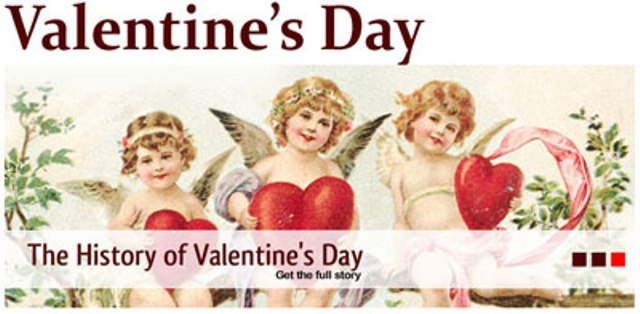The Brief History of Valentine Day

Valentine's Day
Just how did it come about?
Once upon a time...in ancient Rome, February 14th was a holiday to honor Juno. Juno was the Queen of the Roman gods and goddesses. The Romans also knew her as the goddess of women and marriage. The following day, February 15th, began the 'Feast of Lupercalia' (festival of the wolf) which was one of the 'most important' in Imperial Rome.
For eight hundred years prior to the establishment of Valentine's Day, the Romans had practiced a pagan celebration in mid-February commemorating young men's rite of passage to the god Lupercus. The celebration featured a lottery in which young men would draw the names of teenage girls from a vase. During the festival, the pairs of children danced and played together. The girl assigned to each young man in that manner would be his companion during the remaining year. Often, they would fall in love and would later marry.

In an effort to do away with the pagan festival, Pope Gelasius ordered a slight change in the lottery. Instead of the names of young women, the box would contain the names of saints. Both men and women were allowed to draw from the box, and the game was to emulate the ways of the saint they drew during the rest of the year. Needless to say, many of the young Roman men were not too pleased with the rule changes.
Although the lottery for women had been banned by the church, the mid-February holiday in commemoration of St. Valentine was still used by Roman men to seek the affection of women. It became a tradition for the men to give the ones they admired handwritten messages of affection, containing Valentine's name. This may have been the festival that was later named after the former saint -- Valentine's Day. It all started many centuries ago, during those times when being a Christian was against the law. One of the legends says that a Roman Emperor, Claudius the Second, had forbidden his men to marry. He wanted them to be heartless and fearless soldiers, free of wives and girlfriends. Claudius apparently decreed that no marriages should be celebrated and that all engagements be broken off immediately. But one of the Christian priests didn't obey the Emperor's edict. Like Father Lorenzo in Romeo and Juliet, this priest (whose name was Father Valentine) secretly performed marriages in and around the city of Rome. Found out not too long later, Valentine was imprisoned where he languished and died. Legend has it that devoted friends buried him in the church of St. Praxedes on the fourteenth of February, 270 AD.
Father Valentine was a kind and wise person who had a lot of friends. They begged the Emperor to free him and sent letters and flowers to jailed Valentine. Many experts think that these were the first letters and flowers sent on Valentine's Day.
Another story says that Valentine was an early Christian in the time when Rome was unfriendly to this upstart religion. For helping some Christian martyrs he was seized, dragged before the prefect of Rome and cast into jail. There he was said to have fallen in love with, and cured the keeper's daughter, Julia, of blindness. When news of this miracle spread, Rome's leaders gave orders that Valentine should be beheaded. The morning of the execution, he is said to have sent Julia a farewell message signed, "From your Valentine."
History tells us the first modern valentines date from the early years of the fifteenth century. The Young French Duc d'Orleans was captured at the battle of Agincourt and kept a prisoner in the Tower of London for a number of years. The duke wrote a series of poems to his wife from captivity. About sixty of them remain. They can be seen among the royal papers in the British Museum.
Flowers as valentines appeared nearly two hundred years later. A daughter of Henry IV of France gave a party in honour of St. Valentine. Each lady received a bouquet of flowers from the man chosen as her valentine.
During the Middle Ages, Europeans believed that birds chose their mates each year on February 14. In the 17th century, it's believed that lovers began exchanging mementos on Saint Valentine's Day, perhaps heeding the words of Shakespeare's Hamlet: "Sweets to the sweet."

During the medieval days of chivalry, the names of English maidens and bachelors were put into the box and drawn out in pairs. Each couple exchanged gifts. The girl became the man's valentine for that year. On his sleeve he wore her name and it was his bounded duty to attend and protect her. Hence the expression, 'He wore his heart on his sleeve.'
Cupid, another symbol of the holiday, became associated with it because he was the son of Venus, the Roman god of love and beauty. Cupid often appears on Valentine cards.
Although today's society is very different from what it was during Valentine's days, the tradition is alive. The old-fashioned love still has a place in our very advanced and a bit crazy century. Deep down in our hearts we are still hoping to find the kind of love that Shakespeare wrote about.......
However the custom of Valentine's Day started, it remains an enduring tradition for in the world to this day. So have a happy Valentine's Day!

Congratulations @anamul22! You have completed some achievement on Steemit and have been rewarded with new badge(s) :
Click on any badge to view your own Board of Honor on SteemitBoard.
For more information about SteemitBoard, click here
If you no longer want to receive notifications, reply to this comment with the word
STOP